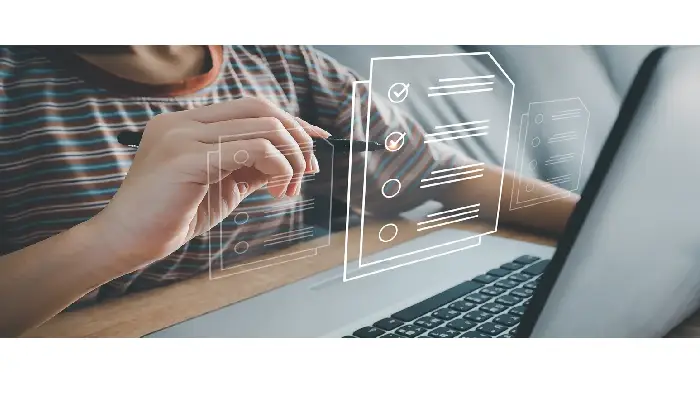
How to Ensure Security in Remote Test Proctoring?
To ensure security in remote test proctoring, a multifaceted approach is essential. First, employing robust identity verification methods like biometric authentication can confirm that the candidate taking the test is indeed registered. A secure browser is crucial, as it limits access to unauthorized websites during exams. Monitoring technology, including live proctoring and AI analysis of behavior patterns, helps detect any undue activities. Conducting environment scans at the exam’s start can further eliminate cheating risks. Data should be encrypted to mitigate breaches while offering clear pre-exam instructions prepares students effectively for what’s ahead. Additionally, technical support and feedback mechanisms promote continuous improvement in this evolving field.
1. Identity Verification Strategies
Identity verification is a crucial first step in ensuring security in remote test proctoring. To verify that the person taking the test is indeed the registered candidate, institutions can implement biometric authentication methods like facial recognition or fingerprint scanning. These technologies offer a reliable means to prevent impersonation and ensure that only authorized individuals take the exam. Additionally, employing two-factor authentication (2FA) during the login process adds another layer of security, requiring test-takers to provide something they know (like a password) and something they have (like a code sent to their phone). For example, after entering their password, a candidate might receive a text message with a verification code that they must input to proceed, significantly reducing the risk of unauthorized access. By adopting these identity verification strategies, educational institutions can strengthen the integrity of their remote testing environments.
2. Utilizing Secure Browsers
Utilizing secure browsers is a critical aspect of remote test proctoring. These specialized browsers are designed to create a controlled testing environment by restricting access to unauthorized websites or applications during the exam. For example, a lockdown browser can prevent students from copying, pasting, or switching to other applications, which minimizes the chances of cheating.
In practice, when students launch their exams through a secure browser, they are met with a full-screen interface that locks them into their test. This not only enhances security but also helps maintain focus by eliminating distractions. Furthermore, these browsers can be configured to automatically flag any suspicious activity, such as attempts to navigate away from the test interface.
By requiring the use of secure browsers, educational institutions can significantly bolster the integrity of their remote assessments, ensuring that students engage with the material honestly and fairly.
3. Monitoring Technology for Exams
Monitoring technology is a crucial component in ensuring the integrity of remote test proctoring. Live proctoring, which involves monitoring test-takers through webcams and microphones, allows for real-time supervision. This method helps in identifying unusual behavior or distractions that may indicate cheating. Moreover, AI-driven solutions can enhance this process by analyzing patterns in student behavior. These systems can detect anomalies, such as sudden movements or unusual audio, and flag them for review. For example, if a student frequently looks away from the screen or engages in conversation, the AI can alert proctors to investigate further. This combination of human oversight and advanced technology creates a more secure testing environment, making it harder for dishonest practices to go unnoticed.
4. Conducting Environment Scans
Conducting environment scans is a critical step in ensuring the integrity of remote test proctoring. At the start of an exam, test-takers should be required to perform a thorough scan of their surroundings using their webcam or mobile device. This involves showing their desk, chair, and any potential areas where unauthorized materials might be hidden. For example, if a student is taking the exam in a room with bookshelves or other surfaces, they should clearly display these areas to the camera. This process helps verify that no notes, electronic devices, or unauthorized individuals are present. By establishing a clear visual of the test environment, educational institutions can deter cheating and enhance the credibility of the examination process. Moreover, it ensures that candidates understand the importance of maintaining a fair testing atmosphere, ultimately contributing to academic integrity.
5. Ensuring Data Security
Data security in remote test proctoring is crucial to protect both student information and the integrity of the examination process. First and foremost, all data must be encrypted during transmission and storage. This means that any information sent over the internet, such as personal identification or exam responses, should be scrambled to prevent unauthorized access. For instance, using protocols like HTTPS ensures that data sent between the test-taker and the proctoring system remains secure.
Additionally, institutions must comply with data protection regulations such as GDPR in Europe or FERPA in the United States. These laws dictate how personal information should be handled and protected, providing guidelines on consent, data access, and storage. By adhering to these regulations, educational institutions can build trust with students, knowing their data is treated with care.
Moreover, implementing regular security audits can help identify vulnerabilities in the system. This proactive approach not only safeguards data but also enhances the overall integrity of the testing process. For example, by regularly reviewing access logs and monitoring for any unusual activities, institutions can quickly address potential security threats before they escalate.
Lastly, it’s important to ensure that all staff involved in the proctoring process are trained in data security best practices. This includes understanding how to handle sensitive information and recognizing phishing attempts or other security risks. When everyone involved is aware of their role in maintaining data security, the entire remote testing environment becomes more robust against threats.
- Implement end-to-end encryption for all data transmission.
- Use secure, password-protected access to sensitive information.
- Regularly update security protocols and software.
- Conduct routine vulnerability assessments and penetration tests.
- Train staff on data protection policies and best practices.
- Establish clear data retention and disposal policies.
- Monitor and log access to sensitive data to detect unauthorized activities.
6. Providing Pre-Exam Instructions
Clear pre-exam instructions are vital for ensuring that students understand what is expected of them during remote test proctoring. These instructions should outline the rules of the exam, including acceptable behaviors and the consequences of cheating. For example, students should be informed that any unauthorized materials or devices will lead to disqualification. It’s also important to guide students through the technology they will use, such as the secure browser and monitoring software. Providing troubleshooting steps can alleviate anxiety and help students feel prepared. By taking the time to ensure that students fully understand the testing process, institutions can reduce confusion and promote a fair testing environment.
7. Analyzing Post-Exam Results
Post-exam analysis is a critical step in ensuring the integrity of remote test proctoring. After the exam concludes, it’s essential to review recorded sessions thoroughly. This analysis helps identify any suspicious behaviors that may suggest cheating or rule violations. For example, if a student is frequently looking away from the screen or engaging with off-camera materials, these actions can be flagged for further review.
Additionally, performance metrics should be closely examined. Unusual score patterns, such as a sudden jump in scores compared to previous assessments, can raise red flags. By comparing these metrics against historical performance, institutions can pinpoint inconsistencies that warrant investigation.
Using a combination of technology and human oversight in this process can enhance the accuracy of identifying potential misconduct. For instance, AI-driven tools can help in detecting anomalies in test-taker behavior, while trained proctors can provide context and judgment based on their observations. This dual approach ensures that not only are the results accurate, but also that the examination process remains fair and just.
8. Training Proctors Effectively
Training proctors is a crucial step in ensuring the integrity of remote test proctoring. They need to be equipped with the skills to recognize potential cheating behaviors, such as unusual eye movements or excessive distractions in the testing environment. For instance, a proctor trained to notice a test-taker frequently glancing off-screen might intervene appropriately, ensuring that the exam remains secure.
Effective training should also cover how to manage the examination process smoothly, fostering a balance between security and a comfortable testing atmosphere. This includes understanding how to communicate with students during the exam, addressing their concerns without causing anxiety, and knowing when to escalate issues to technical support.
Role-playing scenarios can be a useful training tool, where proctors practice handling various situations they might encounter. This hands-on approach helps them gain confidence and prepares them to act decisively and fairly. Moreover, ongoing training sessions and updates about the latest cheating techniques and proctoring technologies are essential for keeping proctors informed and effective.
Frequently Asked Questions
1. How do proctors prevent cheating during remote tests?
Proctors use various tools like video monitoring, screen sharing, and browser lockdowns to watch for any suspicious behavior and prevent cheating.
2. What technology is used to verify a test taker’s identity?
Identity verification often involves using webcams to take photos of the test taker, scanning IDs, or utilizing biometric data like facial recognition.
3. Can remote proctoring be done on any device?
Most remote proctoring systems work on computers, but some might have restrictions on mobile devices or require specific software to function properly.
4. What happens if a test taker experiences technical issues during the exam?
If technical problems occur, test takers can usually reach out to support for assistance or may be allowed to reschedule the exam under certain conditions.
5. How is the privacy of test takers protected during remote proctoring?
Privacy is protected through strict data handling protocols and encrypting personal information, ensuring that only necessary data is accessed and stored.
TL;DR To ensure security in remote test proctoring, implement strong identity verification methods, use secure browsers, and employ monitoring technology. Conduct environment scans, protect data, and provide clear pre-exam instructions. Analyze post-exam results for suspicious behavior, train proctors effectively, and establish feedback mechanisms. Offer technical support and keep systems updated while ensuring legal compliance and ethical standards.
Resource URL:
https://en.wikipedia.org/wiki/Proctor
https://proctor360.com/solution/remote-proctoring-for-test-centers



